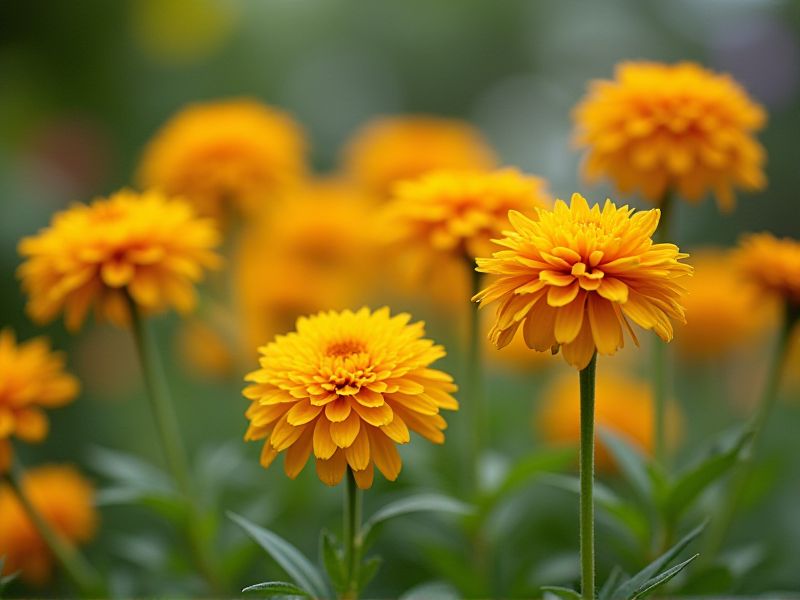
Drought-resistant flowering plants, such as lavender, succulents, and black-eyed Susans, are excellent choices for landscapes requiring minimal water. These plants have adapted to survive harsh conditions through mechanisms like deep root systems and thick, waxy leaves that retain moisture. Not only do they add vibrant colors to your garden, but they also contribute to sustainable gardening by reducing water consumption. Incorporating these resilient species helps create a low-maintenance landscape that thrives during dry spells. Considering these options can enhance your outdoor space while supporting eco-friendly practices.
List of some Blooming plants that resist drought
- Lavender (Lavandula)
- Russian Sage (Perovskia atriplicifolia)
- Blanket Flower (Gaillardia)
- Coneflower (Echinacea)
- Yarrow (Achillea millefolium)
- Lantana (Lantana camara)
- Salvia (Salvia nemorosa)
- Sedum (Sedum spectabile)
- Rock Rose (Cistus)
- Verbena (Verbena bonariensis)
Important things about Blooming plants that resist drought
Drought-Tolerant Species
Drought-tolerant blooming plants, such as *Lavandula* (lavender) and *Salvia* (sage), thrive in arid conditions while adding vibrant color to your landscape. These species possess deep root systems, allowing them to access water from lower soil layers and survive prolonged dry spells. Complementing their aesthetic value, many drought-resistant blooms require minimal maintenance and are excellent choices for sustainable gardening. Incorporating these resilient plants can create a stunning garden that conserves water and supports local ecosystems.
Deep Root Systems
Blooming plants with deep root systems are remarkably effective in drought resistance, enabling them to access water from deeper soil layers that surface plants cannot reach. These robust root networks not only support the plants during dry spells but also promote soil health by preventing erosion and improving nutrient cycling. Some exemplary species include the desert marigold and the flowering acacia, which thrive in arid environments due to their extensive root structure. By selecting such plants for your garden, you can create a resilient landscape that conserves water and blossoms beautifully even in challenging conditions.
Succulent Leaves
Succulent leaves are a defining characteristic of drought-resistant plants, enabling them to thrive in arid environments by storing water efficiently. These specialized leaves often have a thick, fleshy texture, which minimizes water loss through evaporation. Species such as aloe vera, agave, and various types of jade plants showcase the remarkable adaptations of succulents, including reduced leaf surface area and a waxy cuticle that further protects against dehydration. By incorporating these lush plants into your garden, you can enjoy a vibrant, low-maintenance landscape that flourishes even in dry conditions.
Water-Efficient Adaptations
Certain blooming plants, like the California poppy (Eschscholzia californica) and succulents such as Aloe vera, are excellent choices for water-efficient gardens, thriving in arid conditions. These plants possess specialized adaptations, including deep root systems and fleshy leaves that store moisture, allowing them to survive prolonged periods of drought. Utilizing native species or drought-tolerant varieties not only enhances the resilience of your garden but also supports local ecosystems by attracting pollinators. By incorporating these water-wise plants, you can create a vibrant landscape while conserving precious water resources.
Native Plant Options
Choosing native plants that bloom and resist drought can enhance your garden's resilience and beauty. Species like the California Poppy (Eschscholzia californica) and Blanket Flower (Gaillardia spp.) thrive in arid conditions while providing vibrant color throughout the growing season. Incorporating these plants supports local ecosystems, attracting beneficial pollinators like bees and butterflies. Select drought-tolerant native blooms to create a sustainable landscape that requires minimal irrigation.
Soil Type Preferences
Blooming plants that resist drought thrive best in well-drained soil types, such as sandy or loamy soils, which allow for efficient water retention while preventing waterlogging. These plants, including succulents and native perennials, often prefer soils rich in organic matter, promoting moisture retention and nutrient availability. Incorporating mulch into your soil can enhance moisture retention and protect plant roots from extreme temperature fluctuations. Understanding your specific soil composition will help you select the right drought-resistant blooms for your garden, ensuring vibrant growth even in arid conditions.
Seasonal Blooming Patterns
Blooming plants that resist drought showcase remarkable adaptations, enabling them to thrive in arid conditions while providing vibrant colors to landscapes. Varieties such as succulents, xerophytes, and native wildflowers often exhibit seasonal blooming patterns, timed to coincide with rare rainfalls, maximizing their reproductive success. Examples like the desert marigold and evening primrose bloom profusely, drawing pollinators while conserving water effectively through specialized mechanisms. For your garden, selecting drought-resistant flowering plants can enhance aesthetics while contributing to water conservation efforts.
Minimal Maintenance Requirements
Blooming plants that resist drought are ideal for low-maintenance gardens and landscapes. Varieties such as lavender, succulents, and Echinacea provide vibrant flowers while requiring minimal water once established, making them perfect for xeriscaping. These resilient plants thrive in well-draining soil, often with little fertilization needed, promoting an eco-friendly, sustainable approach to gardening. By incorporating drought-resistant blooms, you can create a colorful, thriving outdoor space that conserves water and minimizes upkeep.
Pest And Disease Resistance
Blooming plants such as Echinacea, Sedum, and Lavender exhibit remarkable drought resistance while also offering vibrant flowers that attract pollinators. These hardy species possess adaptations that enable them to thrive in arid conditions, including deep root systems and waxy leaf surfaces that minimize water loss. You can enhance your garden's resilience by incorporating these plants, as they not only withstand pests but also enhance biodiversity. By choosing drought-resistant blooming plants, you create a sustainable landscape that flourishes even in challenging environments.
Environmental Benefits
Blooming plants that resist drought, such as succulents and native wildflowers, play a crucial role in sustainable landscaping and ecological restoration. These drought-resistant species conserve water, lower irrigation needs, and reduce maintenance costs, making them ideal for arid regions. By enhancing soil health and promoting biodiversity, these resilient plants support local wildlife and pollinators, contributing to healthier ecosystems. Choosing drought-tolerant blooms not only enriches your garden but also mitigates the effects of climate change, promoting a more sustainable future.
